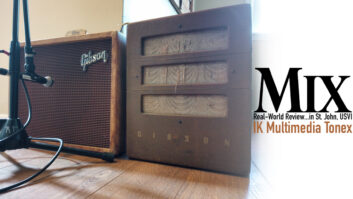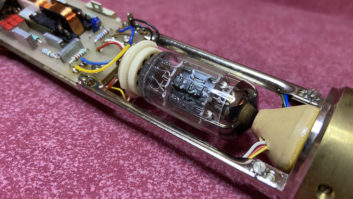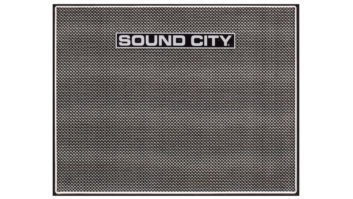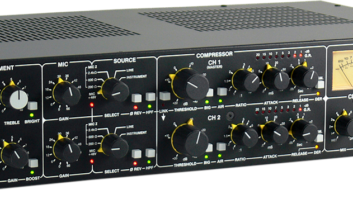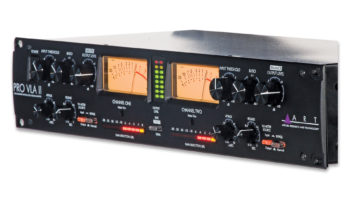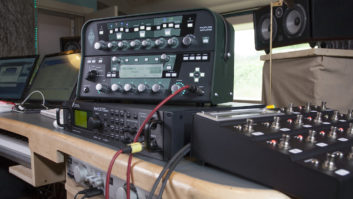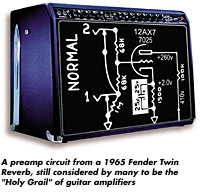
I have more than a passing interest in guitar-amplificationtechnology, specifically the tubular variety. Here are a few tips thatrange from safety to sonics, and noise immunity to tube testing. As youknow, the inner workings of tube amps can expose you to hazardousvoltage. Proceed at your own risk: Keep one hand in your pocket andwear shoes, please! No bare feet!
NO MORE HOT LIPS
Anyone who’s been “zorched” by a nasty shock when yourlips touch a mic while playing through a miswired guitar amp willappreciate this: All guitar amps with a two-pronged AC power plug willmost likely have a ground switch. The switch must be removed and athree-conductor cable installed, initially without attaching the ground(green wire). Unplug the amp before soldering. There are two possibleways to connect the black and white wires (hot and neutral,respectively) from the new power cable. Determine correct orientationfirst by connecting an AC voltmeter from the chassis to a known ground:the third “hole” or plate screw of the AC outlet. Of thetwo possible voltages — the “wrong” one will be inthe neighborhood of 60 volts — choose the connection that yieldsthe lesser of the two and then connect the green wire to the chassis.No more hot lips!
MAGIC TRICKS
Guitar amps and other “classic” audio gear are all aboutnuance. One fairly simple explanation for this magic is simply to countthe number of “active devices,” tubes or transistors. Keepin mind that a typical IC operational amplifier may have two-dozentransistors. We all know what op amp clipping sounds like: It’s nastyand symmetrical, but from noise floor to fuzz, it’s linear-clean allthe way. This is a design goal; an op amp is not supposed to havecharacter, just like digital without plug-ins.
The magic, which just about everyone is looking for, originates froma single tube or transistor gain-stage running at full-bore.Between linear-clean and full-overdrive is the region that Irefer to as “the sonic air bag,” that classic richness fullof lovely, inherent flaws (distortion). Some designs have an inherentlylarger air bag.
A guitar amp with four output tubes and four dual-triodes becomes abaker’s dozen of devices if a tube rectifier is included. While theactual number of gain stages in the primary signal path is less thanthis total, each device makes it mark. Changing the tube rectifier tosolid-state will reduce the amount of “sag” in the powersupply when the power amp is overdriven. Choosy guitarists utilizetubes even in the power supply.
While vacuum tubes do have unique sonic characteristics, they can beconfigured to deliver linear performance like an op amp. Whethersolid-state or “valve,” an op amp benefits from a greaternumber of active devices, capable of incredible amounts of gain, butoperating far more comfortably in their linear region. Add somenegative feedback to reduce gain (as required by the task at hand) anddistortion is reduced, as well — to nearly unmeasureable levelsacross the dynamic range — until the AC signal hits the DC powersupply rail(s). There’s no nuance in hard clipping; lots of gain equalsgobs of sustain, aka, instant fuzzbox.
TUBE E OR NOT TUBE E?
For circuit designs that are all about character, every componentplays a role, from the amplification devices to the resistors andcapacitors. And when vacuum tubes are considered, heat not onlyaccelerates the aging process of all components, but also changes theirproperties as temperatures shift from cold to hot. This vacillation isgood to keep in mind if a tube replacement yields a temporary fix orwhen you’re specifically looking for “masked” or sporadicproblems.
Everyone knows to scrutinize plate resistors for noise, but anothersource could be the cathode resistor, although its noise may be“hidden” by the bypass cap. If disconnecting the capreveals some “rocky” noise, then that resistor should bereplaced. In addition, a funky/thermal cap might be responsible forintermittent noise and frequency anomalies. The figure shows an inputpreamp schematic from a Fender Twin Reverb. The white section indicatesthe cap in question.
PRE-STRESSED
Some tube vendors specialize in selling “glassware” thatis pre-tested and selected for high performance. Audiophiles pay apremium for this type of service, though it generally does not apply tostudio and guitar types who require a better value for their dollar.Tube performance varies among manufacturers — especially now— and even compatible tubes like the 6L6 and 5881 are verydifferent, the latter being far more linear.
It is common to match power tubes so that each equally sharesthe load. These days, I recommend that all tubes be testedbefore purchase, even in the most basic way, at minimum, to screen theclunkers. All equipment manufacturers (hopefully) put their valves tothe test, selecting the best for preamps: delegating the noisier“bottles” to driver duty, with the rest ending up in thetrash.
PRE-TESTING THE 12A?7 DUAL-TRIODE
Many circuits rely on several 12A?7-type tubes, the “?”may be a “U” or a “T” or an “X,”just a few of the letters that refer to performance characteristics,the most obvious of which is gain. (In tube lingo, that’s amplificationfactor. For semiconductors, it’s called Beta.) Military tubes have onlya four-digit number instead. Tube and transistor parameters have atolerance window that varies during production; the differences betweennew-old-stock (NOS) and more recent products can be extreme.
Most tube-testers measure only “static electronemission,” enough to determine that a tube is functioning asdisplayed on either a numeric or a bad/good meter. A tube could test“good” and also be bad if it suffers from“gas,” a condition that can cause extremely nonlinearamplification. Because just about everything tubular uses a 12A?7, Ibegan by testing each triode section for “equal emission.”The booklet included with my “Supreme” TV-7/U military testset specifies a “minimum value” of 32 per triode. (Thisnumber is specific to the tester and does not relate to any other unitor specified parameter.)
It is easy for military-grade NOS tubes to meet this spec andhave nearly identical triode sections — off-the-shelf — butit is far less common among modern tubes, hence the need forpre-testing. Variable-mu compressors and some Pultec amplifiers prefer“matched” triodes, while most preamps do not. I use thistest only to weed out the junk.
Okay, so maybe you’re not going to test tubes, although testers areavailable from eBay, some with full-service documentation. So whenpurchasing tubes, request that the dual-triodes be selected for a bestmatch. I happily paid a $1-per-tube additional charge last year (wellworth the cost), compared to the extremely poor-quality tubes I wassent the first time by the same company!
TESTING: ONE, TWO, THREE
Whether in a guitar amp or a mic preamp, a high-gain circuit is theperfect rig for noise tests. There’s no space here to provide enoughexamples: Simply tap on all of the tubes while the gain is up todetermine “the sensitive one.” Then, short the inputconnector (if applicable) and listen to the “tubesymphonia” as the preamp is powered up. A whole array of whooshesand clinks can be heard as metals expand. When things settle down, notethe noise. Your memory should be good enough for comparisons, but fordocumentation, find a high-resolution digital meter. Cool Edit Pro’slevel meter is worth the price of the software alone at www.syntrillium.com.
The noise spectrum will vary considerably from loud to not-so-loud,rocks or hiss, plus another variable known as microphonics. High-gaintubes must be built to exacting tolerances for mechanical noiseimmunity. Unlike transistors, tubes can resonate to the point ofoscillation if they’re in the same enclosure as a soloing guitarist’sloudspeaker. For the purpose of microphonics and noise testing, all ofthe 12A?7 family can be tested in the high-gain socket. Keep in mindthat lower-gain tubes like the 12AU7 will have less noise.
BIAS
Of the many contributors to a guitar amp’s efficiency and overloadcharacteristics, output tube bias is one of those voodoo variables.Mesa Engineering solved this issue by “fixing” the bias toa value that matched its pretested tubes, choosing only those valvesthat make the grade both at the time of manufacture, as well as futurereplacement. Other amps have adjustable bias that can easily bemisadjusted.
The purpose of bias is to set a comfortable operating environmentfor the output tubes that will optimize their life and minimize nastycrossover distortion in a push-pull (Class-A/B) circuit. Many amps runthe plate voltage at maximum so that only higher-performance tubes cando the job. Electro-Harmonix (www.sovtek.com) claims its 6V6 EH can tolerate thejuice that Fender Deluxe and Champ amps deliver. The easiest way toobserve this is to watch the tubes in a dark room. Only the filament issupposed to glow red and not the outer shell, called the plate. This isthe result of the grid being too positive (beyond Class-A).
A grid that’s too negative (Class-B) will make the amp run muchcooler, but it won’t sound very good. There are many ways to optimizebias, including some after-market boxes from Groove Tubes (www.groovetubes.com) that make the process“more safe.” The highest voltages are at the output tubesockets, so if you don’t want to invest $120 in the kit, then you maywant to leave this tweak to a pro.
Eddie Ciletti is Mix’s resident tech. Visitwww.tangible-technology.comfor morefun.
